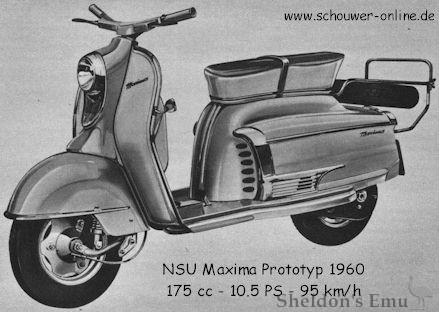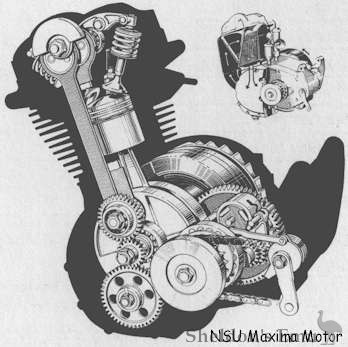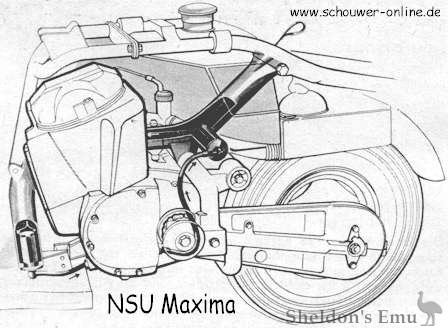



Anfang der sechziger Jahre unternahm NSU noch einen Versuch, Marktanteile im Rollergeschäft zurückzuerobern. Ein Roller im bewährten Prima-Design und mit einem ausgereiften, dynamischen Viertaktmotor sollte das Ruder herumreißen. Trotz aller Vorschusslorbeeren kam es nicht mehr zur Serienfertigung. Was könnte die Stimmung kurz vor der geplanten Vorstellung zur IFMA 1960 besser wiedergeben als ein Zitat aus einer Fachzeitschrift (Ausgabe 09/1960):
NSU Maxima mit Viertaktmotor
Am meisten interessieren sich Freund und Feind für die neue NSU Maxima, deren Name andeutet, wie sie entstand: NSU richtete den 175-ccm-Viertakt-Motor des Motorrads Maxi für den Prima-Roller her: Maxi + Prima = Maxima.
Äußerlich unterscheidet sich die Maxima von der Prima nur durch die abgeänderten Seitenteile; sie hat ein dickeres Hinterteil als die Prima, denn der Maxi-Motor ist ein ganz schöner Brocken, und es war gewiss nicht leicht, ihn überhaupt unterzubringen.
Für den Einbau in den Roller erhielt der Motor Gebläsekühlung, der Öltank wurde den Raumschwierigkeiten entsprechend sehr geschickt abgeändert, wie die untenstehende Zeichnung zeigt. Als Leistung ergeben sich für den Roller 10,5 PS, die für echte 95 km/h gut sein dürften.
Rein konstruktiv bedeutet der Einbau eines Motorradmotors in die Prima einen technischen Rückschritt: Die eigentliche Prima mit dem Zweitaktmotor hat eine geschlossene Triebsatzschwinge mit liegendem Zylinder, Getriebe neben dem Hinterrad und dementsprechend einseitiger Radführung hinten. Aus dieser Anordnung ergibt sich der Vorteil eines wartungsfreien Antriebs, sehr niedrigen Schwerpunkts und leichter Radmontage: derartige geschlossene Triebwerke gelten allgemein als großer Fortschritt gegenüber der Verwendung von Motorrad-Motoren, die mit ihren stehenden Zylindern, dem wartungsbedürftigen Kettenantrieb und ihren Schwinggabeln mit Steckachse für den Roller nicht ideal sind.
Das Argument für die Verwendung von Motorrad-Motoren war von jeher mehr eine Entschuldigung: Es handele sich um ausgereifte Triebwerke, die das Risiko von Kinderkrankheiten sparten. So kann man auch zur Verwendung des Maxi-Motors in der Maxima bei allem Bedauern darüber, dass kein geschlossenes Triebwerk mit liegendem Zylinder und Kardanweile geschaffen werden konnte, doch von vornherein sagen, dass es ein sehr guter und leistungsfähiger Motor ist. Und der erste Blick des kritischen Betrachters findet auch gleich, was er aus gutem Grund suchte: Das Triebwerk ist in Gummi aufgehängt. Starre Aufhängung einer von Natur vibrationsfreudigen Viertaktmaschine hätte von vornherein einen Komfortmangel bedeutet. Wenn starre Motoraufhangung beim Motorrad noch hinzunehmen ist, so ist sie beim Roller mit seinen schwingungsfreudigen Rahmen und den Resonanzen und Klapperneigungen unter dem Blech längst nur noch bei wenigen besonders laufruhigen Zweitaktmotoren mit liegendem Zylinder hinzunehmen.
Bei der Maxima ist also das Triebwerk in Gummi gelagert, sie hat nun eine weniger elegante, dafür aber besonders steife Hinterradführung, ihre Fahreigenschaften waren von jeher schon sehr gut, und sie sieht hübsch aus; zusammen mit dem Viertakter ist das wohl ein ausreichendes Kapital für den Kampf mit den Konkurrenten, auf den die Neuentwicklung zielt: Heinkel.

Schon seit langem kann man beobachten, wie NSU mit einer gewissen Ratlosigkeit vor der Tatsache steht, dass Vespa einerseits und Heinkel andererseits immer besser verkaufen, während NSU mit der Prima einfach nicht recht zum Zuge kommt, obwohl das Fabrikat durch die NSU-Lambretta so einen hervorragenden Start hatte und zeitweise in dieser Klasse sogar marktbeherrschend war. Tatsächlich ist es schwer, mit voller Sicherheit zu sagen, was eigentlich an der Prima nicht recht Anklang fand und findet. Sicher ist, dass eine Kinderkrankheit ihr viel Sympathie bei den Händlern kostete und eine andere Kinderkrankheit viel Sympathie bei den Käufern: Es gab anfangs viel Kummer, weil sie Schmutz ansaugte mit entsprechenden Folgen, und es war ein Komfortmangel, dass sie trotz geschickter Triebwerksanordnung außerordentlich stark vibrierte. Um die erste Krankheit gab es viel Garantie- und Kulanzaufwand, die zweite wurde durch eine neue Ausführung mit Gummilagerung der Triebsatzschwinge erledigt, aber der Start war verdorben und die Prima fand auch im ganzen nicht den Anklang, der der Lambretta-Prima sicher gewesen war, trotz Nebellampe, E-Starter und Breitskala-Tachometer. Also machte NSU als Anti-Vespa die Prima III K und KL mit erheblich gesenkten Preisen, ohne damit den Anstieg der Vespa-Ziffern verlangsamen zu können. Und nun wendet man sich - irgendwie muss es ja mal klappen - dem anderen erfolgreichen Gegner zu. Wenn schon die Prima im Volke nicht als leichter Roller und damit Vespa-Äquivalent gilt wie einst die Lambretta (und sie wiegt ja auch 30-40 kg mehr!), so meint man nun doch in der schweren Klasse Chancen zu haben. So entstand die Maxima, in der sich natürlich auch in gewissem Sinne die Motorradentwicklung auch beim Roller bezahlt machen soll.
Wie steht es nun mit diesen Chancen? Was bietet die Maxima gegenüber dem Heinkel? Wir hoffen, die Maxima schon bald gründlich testen zu können, man kann aber schon von der Anlage her ungefähr sagen, wie sie zum Heinkel steht: Vor allem bietet sie mehr Temperament und Leistung; der Maxi-Motor ist ausgesprochen sportlich. Dies dürfte das zentrale Argument sein, mit dem die Maxima für sich werben kann. Denn das einzige wirklich wirksame Kampfmittel gegen einen starken Konkurrenten, nämlich eine Preisunterbietung, war in Richtung auf den Heinkel ebenso wenig möglich wie bei der Prima III K in Richtung auf die Vespa: Die Maxima I (ohne Reserverad und Gepäckträger) kostet mit 1948 DM 8 DM mehr als der Heinkel, der für seine 1940 DM immerhin auch eine Blinkanlage bietet und auch sonst der Maxima ausstattungsmäßig etwas überlegen ist (Gepäckfach!). Als Maxima II (mit Reserverad und Gepäckträger) bietet die Maxima mit 1995 DM einen gewissen Preisvorteil gegenüber dem Heinkel, der mit Reserverad und Gepäckträger 2044 DM kostet, jedoch entspricht die Preisdifferenz gerade etwa den Kosten, die man für den Einbau einer Blinkanlage in die Maxima anlegen müsste.
In den technischen Dingen gleicht sich das Angebot von Maxima und Heinkel durchaus; beide haben Triebwerksaufhängung in Gummi, mit wesentlichen Unterschieden der Federungsqualität ist nicht zu rechnen, die Räder sind mit 3,50-10 gleich. Die Maxima ist - bei gleichem Gewicht - wohl etwas magerer und handlicher als der Heinkel, und für viele Fahrer ist auch die Fußschaltung der Maxima schätzenswert, jedoch ist als Heinkel-Vorteil andererseits anzuführen, dass die Pflege der Kette und das oft lästige Spureinstellen nach dem Radwechsel bei ihm wegfällt.
Man kann also nur schwer voraussagen, wie sich die Maxima einführen wird; sicher ist, dass sie als in der Form nicht abstechendes Glied in der Reihe der Prima-Typen von vornherein nicht so auffällt wie der Heinkel und dass dieser mit dem Repräsentationswert seines Namens und seiner neuen Karosserie in seinem moralischen Kapital fast unangreifbar ist. Die starke Maxima wird in erster Linie Fahrer mit sportlichen Interessen ansprechen, und bei den sportlichen Wettbewerben kann sie ein scharfer Hecht im Heinkel-Karpfenteich werden.
Das übrige Programm von NSU bleibt gleich; die Zweitakt-Prima-Typen sind inzwischen gut ausgereift und bewähren sich allgemein; mit ihrer modernen Gesamtanlage und besonders ihren sehr guten Fahreigenschaften sind sie ohne Zweifel überlegene Nachfolger der NSU Lambretta. Der Vespa haben sie ihre höhere Leistung voraus, der die Fahreigenschaften entsprechen, die Prima III gibt es ebenso mit Kickstarter wie mit EStarter, und die Vereinigung von hohen Reisegeschwindigkeiten auf Fernstrecken mit angenehmen Eigenschaften im Kurzstreckenverkehr machen die Prima eigentlich in ihrer Art nicht weniger konkurrenzlos, wie es die Vespa mit ihrer besonderen Anlage ist. Die NSU Prima V mit 175 ccm-Zweitaktmotor wird ebenso wie die Prima III-Typen trotz Maxima weitergebaut. Alle Typen gibt es mit Sitzbank; von der Maxima unterscheiden sich die Zweitakter nur durch die schmalere Motorverkleidung.

Der Ölvorrat ist auf originelle Weise untergebracht; ein interessanter Unterschied zur einfachen Gehäusefüllung beim Heinkel.
Unter dem Artikel steht der folgende Hinweis: Letzte Meldung kurz vor Drucklegung: Die neue NSU Maxima erscheint zur IFMA noch nicht !
Nach meiner Kenntnis wurden alle Prototypen zerstört. Ein damals nicht gelöstes technisches Problem war die Kraftübertragung vom elastisch gelagerten Motor zum starr eingebauten Antriebsritzel der Hinterradkette.
Gebaut wurden nur wenige Prototypen. Wer weiß etwas über deren Verbleib?
Haben Sie Material zum Thema "NSU Maxima"? Bitte setzen Sie sich per e-Mail mit mir in Verbindung (webmaster at schouwer-online.de), damit hier eine informative Seite zu diesem Thema entstehen kann!
Early sixties undertook NSU one more try, regain market share in the scooter business. A scooter in proven Prima design and with a proven, dynamic four-stroke engine should turn things around. Despite all the praises it no longer came to mass production. What could the mood just before the scheduled presentation to IFMA 1960 better reflect as a quote from a trade magazine (issue 09/1960):
NSU Maxima with four-stroke engine
Most are interested in friend and foe for the new NSU Maxima, whose name suggests, as they arose: NSU briefed the 175 cc four-stroke engine of the motorcycle for the Maxi Prima Scooter Manufacturer: Maxi + Prima = Maxima.
Externally, the Maxima is different from the Prima only by the modified side parts; it has a thicker rear portion than the Prima, because the Maxi-engine is quite a chunk, and it was certainly not easy at all to accommodate him.
For installation in the scooter was the engine cooling fan, the oil tank was the space difficulties amended accordingly very cleverly, as the below drawing shows. When requirements are set for the scooter 10.5 hp, which are expected to be good for real 95 km / h.

Clean design means the installation of a motorcycle engine in the Prima a technical step back: The actual Prima with the two-stroke engine has a closed Unit swing with horizontal cylinder, gear next to the rear and therefore one-sided wheel guide behind. This arrangement gives the advantage of a maintenance-free drive, very low center of gravity and lighter wheel assembly: such closed engines are generally considered great advance on the use of motorcycle engines, with their standing cylinders, the serviceable chain drive and its forks with thru-axle for the scooters are not ideal.
The argument for the use of motorcycle engines has always been more an excuse: If it were fully developed engines that saved the risk of childhood diseases. So you can also to use the Maxi-engine in the Maxima at all regret that not a closed engine with horizontal cylinder and Kardanweile could be created, but say from the outset that it is a very good and powerful engine. And the first glimpse of the critical observer is also equal to what he was looking for a good reason: The engine is suspended in rubber. Rigid mounting a vibration joyful natural four-cycle engine had a priori means a comfort deficiency. If rigid Motoraufhangung the motorcycle is still to accept so long ago is to accept the scooter with its vibration joyous frame and the resonance and rattling inclinations under the sheet metal only in a few exceptionally smooth two-stroke engines with horizontal cylinder.
The Maxima engine is mounted in rubber, it now has a less elegant, but particularly rigid rear suspension, its handling characteristics have always been very good, and it is attractive; together with the four-stroke engine that is probably sufficient capital for the fight with competitors, as referred to by the new development: Heinkel.

For a long time, one can observe how NSU is with a certain perplexity before the fact that Vespa one hand and Heinkel other hand always sell better during NSU with the Prima just did not quite come into play, although the brand as a through the NSU Lambretta excellent start had and temporarily in this class was even dominant. Indeed, it is difficult to say with certainty what actually on the Prima not quite caught on and found. It is certain that a childhood disease cost her a lot of sympathy with the dealers and other childhood disease much sympathy among buyers: There was initially a lot of grief because they ansaugte dirt with consequences, and it was a comfort deficiency that they exceptionally strong despite swift engine assembly vibrated. To the first disease there was plenty of warranty and goodwill expense, the second was completed by a new version with rubber mounting the propulsion unit rotating shaft, but the start was spoiled and the Prima was also in the whole not the appeal that had been sure of Lambretta-Prima, despite fog lamp, electric starter and wide-scale speedometer. So NSU made as anti-Vespa prima III K and KL with significantly reduced prices without being able thus slowing the rise in Vespa digits. And now one turns - somehow it must indeed work times - the other successful opponent. If not already applies the Prima among the people as a lighter scooter Vespa and therefore equivalent as once the Lambretta (and weighs 30-40 kg indeed more!), So we think now but to have opportunities in the heavy class. So the Maxima, in which of course the motorcycle development will pay off even when Roller also in a sense emerged.
What, then, with these opportunities? What provides the Maxima against the Heinkel? We hope to be able to thoroughly test Maxima soon, but you can already tell from the plant about how it is to Heinkel: Above all, it provides more power and temperament; the Maxi-engine is very athletic. This should be the central argument, with the maximums can advertise. Because the only truly effective weapon against a strong competitor, namely price undercutting, toward the Heinkel was no more possible than in the Prima III K toward the Vespa: The Maxima I (without spare wheel and carrier) costs with 1948 DM 8 DM more than the Heinkel, who nevertheless also provides a warning system for its 1940 DM and otherwise the Maxima equipment outnumber something is (luggage compartment!). As Maxima II (with spare wheel and carrier) with 1995 DM offers the Maxima a certain price advantage over the Heinkel, which costs 2044 DM with spare wheel and carrier, but the price difference corresponds precisely about the costs you to install a warning system in the Maxima would create.
In the technical matters, the supply of Maxima and Heinkel resembles quite; both have the engine mount structure in rubber, with significant differences between the suspension quality is not expected, the wheels are from 3.50 to 10 with the same. The Maxima is - at the same weight - probably a bit leaner and more manageable than the Heinkel, and for many drivers is the foot control the Maxima estimable, but is as Heinkel advantage to lead the other hand, that the maintenance of the chain and the often annoying wheel adjustment after Radwechsel invisible with him.
One can therefore difficult to predict how the Maxima will introduce; is sure that they as in the form of not abstechendes member of the series of Prima-types from the outset not as noticeable as the Heinkel and that this is almost untouchable in his moral capital with the representation value of his name and his new body. The powerful Maxima will appeal primarily drivers with sporting interests, and in sporting competitions can be a sharp pike in Heinkel carp.
The rest of the program of NSU remains the same; the two-stroke-Prima-types are now well advanced and proven themselves generally; with their modern overall conditioning, and especially their very good handling characteristics, they are undoubtedly superior successor to the NSU Lambretta. The Vespa they have their higher power forward who meet the driving characteristics, the Prima III there are just as with Kickstarter as with eStarter, and the association of high travel speeds over long distances with pleasant characteristics over short distances make the Prima actually in its way no less unrivaled, as the Vespa with their particular system. The NSU Prima V with 175 cc two-stroke engine, like the Prima III types continued to be built despite Maxima. All types are available with seat; the two-stroke engines differ from the Maxima only through the narrower engine cover.
The oil reservoir is housed in an original way; an interesting contrast to the simple case filling the Heinkel.
Under the article, the following words shall appear: Breaking News shortly before going to press: The new NSU Maxima does not yet appear to IFMA!
To my knowledge, all prototypes were destroyed. A time unsolved technical problem was the power transmission from the elastically mounted motor for rigidly mounted drive pinion of the rear chain.
Please excuse the poor translation.
Archive of a page by Hartmut Schouwer